#mapbox studio
Explore tagged Tumblr posts
Text
Game Of Thrones Map 1080p

Tons of awesome game of thrones map wallpapers to download for free. Dungeon masters guide 5e pdf free download. You can also upload and share your favorite game of thrones map wallpapers. HD wallpapers and background images. Want to make your own GOT-inspired map? Add this map style to your Mapbox Studio account and start designing your own, or build from scratch with the files here. You can add detail to the cities, build those 3D castles, place the family banners, mark the character routes, map the GoT world as it would look based on who rules the Iron Throne at the end — we want to see all the GOT-inspired.
Game Of Thrones Map 1080p
That first minute with the world map is the one thing that links together all the pieces—joining together the show’s various story worlds. Game of Thrones is really a collection of many story. The map above shows the entire ‘Known World’ from Game of Thrones including Westeros and Essos in a Google map style. Given the popularity of Game of Thrones and the fact that geography plays an important role in both the books and TV show, it’s no surprise that maps of Westeros are all the rage these days. Westeros is home to over 500 cities, castles, and landmarks. Our goal is to construct them all. With over 300 completed so far, our community is well on our way to having a fully explorable map. You can keep up with our progress in game anytime, or start exploring our expansive Wiki.
A Minecraft Server
WesterosCraft is faithfully recreating the world of Game of Thrones
over 1.5 billion blocks placed over 7.5 square miles
as seen in
Ready to explore Westeros?
Get our launcher and start your journey
Destinations
Westeros is home to over 500 cities, castles, and landmarks. Our goal is to construct them all. With over 300 completed so far, our community is well on our way to having a fully explorable map. You can keep up with our progress in game anytime, or start exploring our expansive Wiki.
Winterfell
King's Landing
Lannisport
Highgarden
Pyke
View progress
View wiki
Always Evolving
As Minecraft updates and evolves, so too does our server! From simple cobblestone shacks in 2011, to ornate cities in 2020, we have come a long way from our humble beginnings.
Crafting Connections
We're a truly global community, united by a common goal of creating one of the most detailed Minecraft worlds ever built. Whether you're logging on for a quick visit, or you're a long-standing builder, every visitor is a key part of our community.
Get started with WesterosCraft
Ready to start exploring? All you need is a copy ofMinecraft Java Edition

From A Wiki of Ice and Fire
Game Of Thrones 1080p Wallpaper
Jump to: navigation, search
Game Of Thrones Tpb

Note This article is about content invented for the television adaptation Game of Thrones developed by HBO. Although this is a licensed derivative work based upon A Song of Ice and Fire by George R. R. Martin, it is not written by him. The material on this page should not be considered canonical for the novels, and is provided for informational purposes only.
Copyright HBO©
The World Map, published by HBO for its television show Game of Thrones, consists of all the world geographical information up to Season 2. The Lands of Ice and Fire, a canon map collection published in October 2012, contains newer and updated world maps for A Song of Ice and Fire.For additional information on world locations, see the Geography Portal.
North of The Wall

Game Of Thrones Map 1080p Movies
Northern Westeros
Southern Westeros
Game Of Thrones Map 1080p Izle
The impossible game android apk.
Essos (The Lands Across the Narrow Sea)
Game Of Thrones 1080p Online
Regions of the Known World
WesterosEssosSothoryosOther
Game Of Thrones Map 1080p 4k
Retrieved from 'https://awoiaf.westeros.org/index.php?title=World_Map_(HBO_Game_Of_Thrones)&oldid=255744'
3 notes
·
View notes
Text
Six smart steps to configure Mapbox with ReactJS
Mapbox provides custom maps, search and navigation. It supports many platforms. The tool is powered by programmers as well as millions of devices providing Location Data. It provides developers a platform and a toolset to build customized applications where location-based data can be used to meet a variety of business requirements.
A typical scenario where Mapbox is used:
A service provider uses Mapbox to track locations of their assets or employees in order to provide real-time information to customers or for operational monitoring. This could be a restaurant delivery service, an international transport company or even a fleet operator in a city.
Customizing Mapbox
One of our clients provides data services to monitor the health of agricultural farms. They wished to offer compelling data visualization of agricultural farm images along with other details. We customized mapbox to render this information on the web and mobile devices. There are SDKs available for the Web, iOS and Android.
In this article, we share how we configured mapbox in React JS using custom style to add new fonts, custom icons and publish these styles.
Following are the steps to configure mapbox in React JS using custom style to add new fonts, custom icons and publish these styles –
1. Steps to generate the token number and style in Mapbox
a. Create an account on https://account.mapbox.com
b. Log in to your account
c. On the Dashboard look for the Default public token. This Token number can be used for configuration in the Web App. You need to remember that this token number is public and easily accessible from the developer tab.
d. To get the private Token click on the button 'Create a Token' you will get a form. Enter the 'Token name' and select the desired 'Public Scope' and the 'Secret Scopes’.
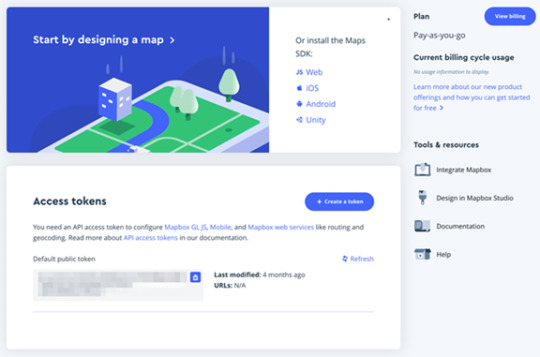
e. Note: - This token will only be accessible from the specific URLs that we add while generating the Token.
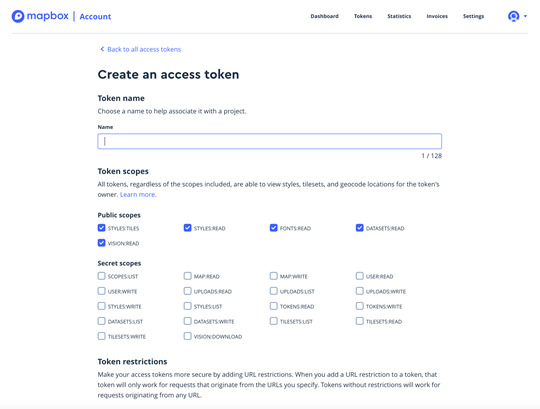
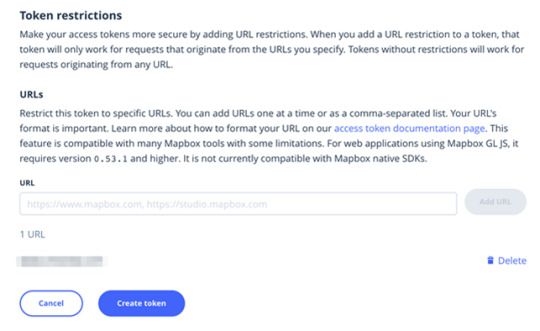
f. Now add the list of comma-separated URLs into the URL field and click on the 'Create Token’. Next you will be asked to confirm with your account password.
g. You will find the private token at the bottom of the Token list.
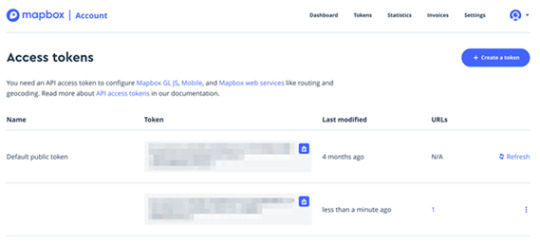
2. Steps to configure React JS app with Mapbox
a. There are two different methods available for using the Mapbox on the web App.We describe the steps using the 'npm' module bundler for installing Mapbox GL JS.
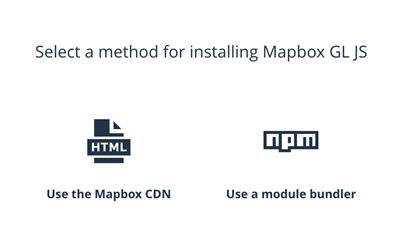
b. Install the 'npm' package --> 'npm install mapbox-gl --save'
c. Include the GL JS CSS file
d. Include the CSS file in the <head> of your HTML file
i. <link href='https://api.mapbox.com/mapbox-gl-js/v1.3.1/mapbox-gl.css' rel='stylesheet' />
e. Add the map to your Web App.
i. var mapboxgl = require(‘mapbox-gl/dist/mapbox-gl.js');
ii. mapboxgl.accessToken = 'Your Token number’;
iii. var map = new mapboxgl.Map({
iv. container: 'YOUR_CONTAINER_ELEMENT_ID',
v. style: 'mapbox://styles/mapbox/streets-v11' // Default style link
vi. });
f. Now you are done with the configuration.
3. Steps to create the custom style of Mapbox
a. To create our custom style for the map, we need to open the Mapbox Studio,
b. To open the Mapbox studio, you can to go to the Dashboard and then click on the 'Design in Mapbox Studio' on the right side of the Dashboard or Just click on the link here https://studio.mapbox.com/
c. After opening the Mapbox studio, you can see the predefined styles you can use directly or you may choose to create a new style.
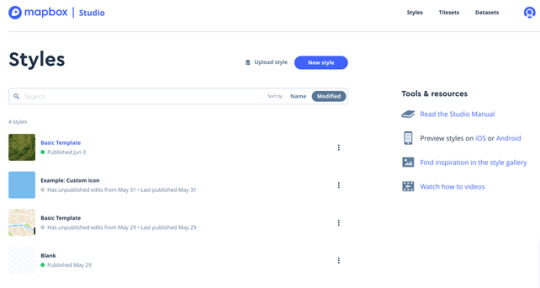
d. To create a new style, click on the 'New style' button on top of the page.
e. Select the desired template from the list and can change the style of the map from bottom of the dialog and then click on the customize button.
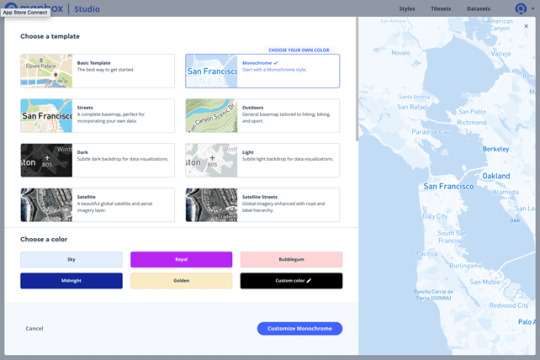
f. You can see a dashboard with different settings.
g. You can update the style of the country label, background, road, buildings and many more
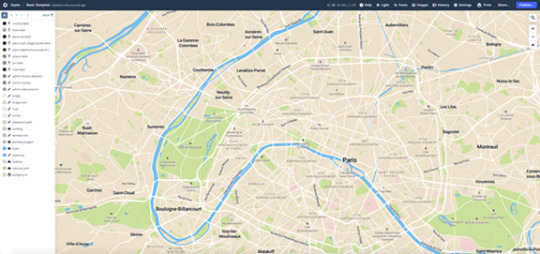

4. Steps to add a new font to the map and then publish for production
a. Click on the Fonts tab on the top-right corner then you can find a dialog to upload the new fonts.
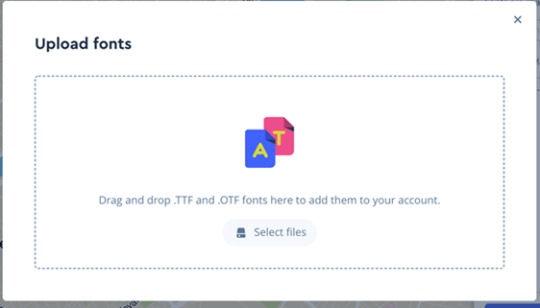
b. Clicking on the Upload new font, you can see a new dialog with the title 'Upload fonts' here you can drag new fonts with extension '.TTF' and ‘.OTF’.
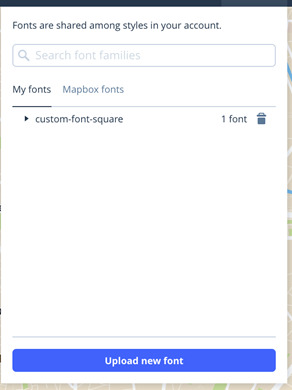
c. Once Font family is added, it can be then used in the map.

5. Steps to add a custom icon or an image and publish
a. The image we upload here will be available as an icon on the map for example Image as a custom marker.
b. Click on the 'Images' tab in the header you can see a dialog to upload the SVG image.
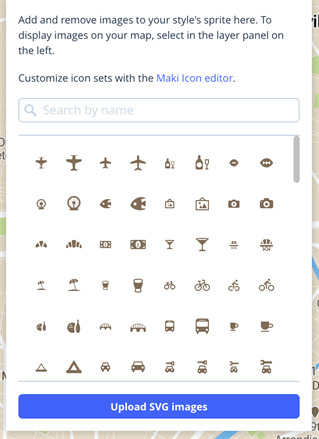
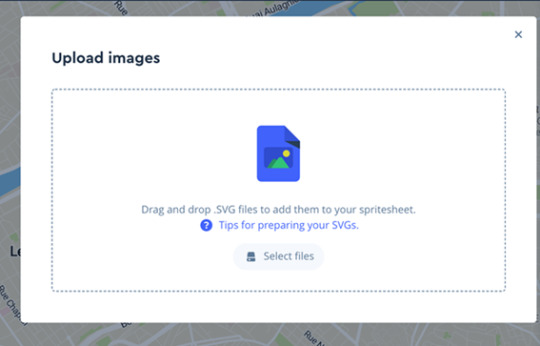
c. To upload the SVG image, click on the 'Upload SVG Icon' button, now you can see a new dialog where you can drag your SVG image.
d. Once you update any style, you have to publish the style to see the changes on the map.
e. Note: - It may take some time to get published and to reflect on the map.
f. It is very easy to publish the changes; you just have to click on the 'Publish' button on the top-right corner of the map box studio.
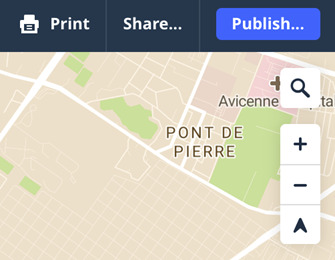
g. Now you can see a dialog with a slider where you can see the styles you added.
h. Here you can either ‘Publish as new’ which will replace all the styles, or, use the ‘Publish’ button to add the styles you added in your draft.
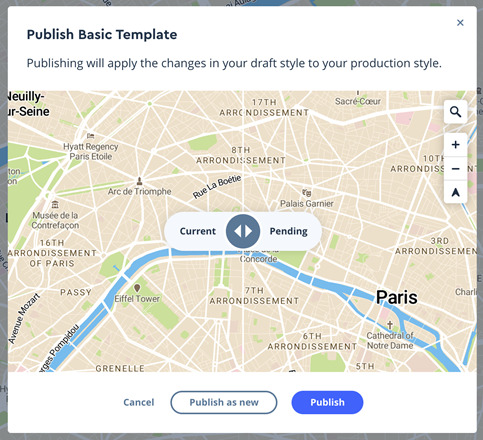
6. Steps to add the updated style to our map
a. Once the style is published,click on the 'Share' tab on the top-right corner of the Mapbox Studio. Here you can see a dialog where you can find your 'Your style Url' and 'Your access token’.
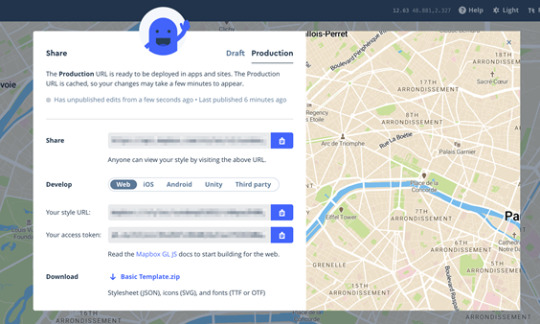
b. Now update your style URL of the map.
i. var map = new mapboxgl.Map({
ii. style: 'Add your style URL Here'
iii. });
c. Example:
i. const feature: feature<FeatureGeometry> = {
ii. id: 123,
iii. type: 'Feature',
iv. geometry: feature.geometry,
v. properties: {
1. meta: feature.meta,
2. icon: 'square-stroke'
3. // Custom Icon name which is added to the style in Mapbox Studio
vi. }
vii. }
For more information on our React projects please visit https://www.metasyssoftware.com/case-study-react
#Configuring Mapbox#mapbox#react#react native#reactjs#custommap#customizing Mapbox#mapbox studio#react customapp#react developers#reactjs app#reactjs example#reactjs web development company
0 notes
Video
youtube
For my project roadmap, this week was meant to be allocated for me to build up the environment within Unity, which basically covers the creating the immersive city. Instead of directly jumping into modelling Manhattan city, I decided to look into city-generation methods and one of them was Mapbox. Mapbox is a package which allows you to instantly bring a flat layout of a city to life by raising buildings and properties up to their height stored in Google Maps’ API. It also has a map editing studio on the browser so that you can cherry pick the components of the map that you want, whether you want labels on cities or roads, bodies of water, buildings, bridges, etc. For now, it seems like my job is done but upon closer inspection, when it’s not running, the main view is basically empty and only upon running the project, does it instantly generate the city that. Although it’s great that you can randomize and change the texture style of the building and also set the generator to add colliders to buildings. But there are several issues with me using Mapbox. One of which is that it’s a pain to add things in the project without actually being able to see where they are unless you run it. Even if you run the project and make changes to it, all the changes are only temporary and gets reverted when you stop the project. Secondly, when I try walking around in the environment, the textures doesn’t seem to match the scale of the scene, in the sense that the size of a window is somehow two stories in size, which isn’t very realistic. Finally the models that are generated seems to have been done fairly imperfectly with an emphasis on it being only viewed from top-down. This means that there are some buildings where if you look from bottom-up in the perspective of a person in the city, you’ll see gaps in the polygons, which is just really weird. On top of that, eve if you keep the geolocation coordinates constant, some buildings miss out on getting generated so you end up with a large empty gap in the middle of the street or just a component of a building missing. Buildings also are not always perfectly parallel or perpendicular of each other, meaning the wall climbing component of my script won’t work properly as well because it requires rotating the character, which has always ended up as a bad idea. Unfortunately, all of these unsolved problems just means that I can’t afford to use Mapbox if I want to move forward, which means I’ll have to start creating my own city tomorrow :(
1 note
·
View note
Link
https://www.google.com/maps/d/u/0/edit?mid=1SPK3SdHinaR80iP_0kfSxqQGyKgF78IV&ll=40.73122240663348%2C-74.0063357995831&z=14Marie Aiello
Chestor Dols
New Media and Digital Design
12/17/18
My mapbox that i put onto google maps its a rough draft the real project is below i had some troubleshooting with the Mapbox https://www.mapbox.com/studio/styles/maiello4/cjpj0hdllhj8z2sqa5xfrzyiz/edit/ to google but i was able to take a tileset and use that to make the google map aswell.
5 notes
·
View notes
Text

Both mapbox vs google maps help the idea of customization, but customization is the number one strength in mapbox. Google map is a piece strict or we are able to say a lot much less flexible close to customization. Google Maps enforce you to use its default base layer, at the opportunity hand, there can be no such restriction on the mapbox.
Mapbox Vs Google maps MapboxMapbox is a complicated and flexible map issuer that can be integrated into mobile apps. Developers should have to get proper access to finish the information to create and customize dynamic and static maps, manner to the Mapbox tilesets.The styled maps can be embedded into net packages with the furnished JavaScript library or to mobile apps with the respective iOS and Android SDKs.The reviews on Mapbox have been encouraging amongst developers and organization owners. While Mapbox isn’t absolutely free, it has a generous free tier in its pricing packages that makes the issuer attractive for apps with a low amount of customers.
ProsPartnership with PubNubMap subject sticks out with geocoding, live facts streaming, asset tracking, dynamic map visualizations with real-time facts, and heat maps — all manner to their partnership with PubNub.
Clustering optionsWhether you’re developing an app for fleet management, traveling, or genuinely everyday navigation needs, it’s vital to fill the map with all of the vital places.
CustomizationMap challenge studio, a platform for growing custom map styles, is a topic of Lego bricks for builders. You can upload or cover objects, accommodate layers in your needs, alternate fonts, colors, or possibly customize a map UI primarily based totally definitely sincerely to your brand style.
ConsPoorer insuranceAs an open-supply solution, Mapbox is based totally mostly on collective mapping and facts assets from unique location offerings, which ends up within the poorer instance of a few areas like India, Israel, and China.
Requires knowledge of curveWorking with Mapbox implies abiding with the useful resource of the use of strict rules, which calls for being used to them however regardless of the reality that can pay off withinside the extended run. Thus, in case you select this virtual map issuer, be geared up to allocate a while and reassets to train your builders or outsource API integration to a dealer with a strong Mapbox experience.
Might disrupt facts processesThis is genuinely the rate you pay for incredible common overall performance delivered to the dynamic experience.
Google mapsGoogle maps are the most well-known SDK for embedding a map into a utility. It’s recounted for its huge database of places and decent routing. It has all the abilities of google maps for mobile app: geocoding, routing, pictures, road view, and places facts. That app is without a doubt based totally mostly on SDK available for public usage. This approach that your clients is probably sincerely comfortable with the use of a map from google because of the reality they most in all likelihood are already familiar with it.
ProsExcellent insurance and records qualityThanks to the street view vehicles, ordinary corrections from clients, and loads of satellite tv for pc television for laptop tv for laptop records, Google maps has no equals in phrases of insurance.
Substantial kind of languagesWith its international reach, google maps offerings are to be had in a large form of languages. You can choose out among eighty language options, on the facet of Afrikaans, Khmer, and Amharic.
Customization optionsThanks to its JSON syntax, you may upload markers, create geo clusters, encompass records windows, customize colors, extrade the style, and modify the opacity of map factors with ease.
ConsGoogle Maps API has positive obstacles in phrases of its browser compatibility. Still, it permits the maximum famous ones: Google Chrome, Safari, Firefox, Microsoft Edge, and Internet Explorer. Find extra records here.Pricing. Google Maps API is notion for its steep expenses and elaborate pricing plans, which we’ll communicate later. However, the first $2 hundred of month-to-month utilization is free.Small utilisation restriction. You ought to make a limited large shape of API calls steady with the second. For facts on the obstacles, click on on on here.
Conclusion Without any doubt, Google maps API is the leader within the vicinity as it’s far running for years and is greater reliable, however, Mapbox API is not a protracted manner within the again of and is offering extraordinary rendering common overall performance and customization with inexpensive pricing.
0 notes
Text
Creating Offline Custom Style Maps With tileserver-gl

Hi lovely people! 👋 Last year, I saw a project on Product Hunt which allowed people to generate posters from maps. The website has since closed down and the company has been acquired by Airbnb. This is what the output looked like: Now, I was interested in figuring out how they were able to render this map. My experience with maps was limited to Google Maps only so I was excited to explore the world of custom map generation. I thought about this project for a while, tried working on it but quickly gave up because of how difficult it was to grasp the basics and get a map rendering pipeline running locally. It wasn’t until recently that I came across an article where the author used Mapbox Studio to create a blueprint style map. That post rekindled my interest in custom map generation and I knew that with the availability of Open Street Maps there is definitely an Open Source software which I can use. Offline rendering options: I could use tileserver-gl or openmaptiles. Both are developed by the same company. The difference is summed up by one of their sales people like this: OpenMapTiles Map Server is better suited for a production environment. It’s a complete package with caching and integrated map services (WMTS/WMS). It is also much easier to set up than TileServerGL. This is especially useful when working with vector map data (such as OpenMapTiles) and dynamically creating raster tiles from such data. Read the full article
0 notes
Video
youtube
[ Interaction Design Studio 2] Week 2.2.1
How to use the updated Mapbox component in Framer X
0 notes
Text
Make Your Business More Accessible with New Blocks
From our support sessions with customers each month, we know that growing your brand or business is a top website goal. And in this unprecedented time in which more people around the world are staying at home, it’s important to promote your products and services online to reach a wider audience and connect with more people.
Our team has been hard at work improving the block editor experience. We’ve launched six new blocks that integrate WordPress.com and Jetpack-enabled sites with popular services — Eventbrite, Calendly, Pinterest, Mapbox, Google Calendar, and OpenTable — enabling you to embed rich content and provide booking and scheduling options right on your blog or website.
Whether you’re an online boutique, a pilates studio, an independent consultant, or a local restaurant, these blocks offer you more ways to promote your brand or business. Take a look at each block — or simply jump to a specific one below.
Eventbrite
Calendly
Pinterest
Mapbox
Google Calendar
OpenTable
Promote online events with the Eventbrite block
Looking for a way to promote an online event (like your museum’s virtual curator talk or your company’s webinar on remote work), or even an at-home livestream performance for your fans and followers? Offering key features of the popular event registration platform, the Eventbrite block embeds events on posts and pages so your visitors can register and purchase tickets right from your site.

Quick-start guide:
To use this block, you need an Eventbrite account. If you don’t have one, sign up at Eventbrite for free.
In the block editor, click the Add Block (+) button and search for and select the Eventbrite Checkout block.
Enter the URL of your Eventbrite event. Read these steps from Eventbrite if you need help.
Select from two options: an In-page Embed shows the event details and registration options directly on your site. The Button & Modal option shows just a button; when clicked, the event details will pop up so your visitor can register.

Learn more on the Eventbrite block support page.
Schedule sessions with the Calendly block
Want to make it easier for people to book private meditation sessions or language lessons with you? The Calendly block, featured recently in our guide on moving your classes online, is a handy way for your clients and students to book a session directly on your site — eliminating the time spent coordinating schedules. You can also use the Calendly block to schedule team meetings or group events.

Quick-start guide:
To use this block, you need a Calendly account. Create one for free at Calendly.
In the block editor, click the Add Block (+) button and search for and select the Calendly block.
Enter your Calendly web address or embed code. Follow these steps from Calendly if you need help.
Select from two styles: the Inline style embeds a calendar directly onto your site; the Link style inserts a button that a visitor can click to open a pop-up calendar.
This block is currently available to sites on the WordPress.com Premium, Business, or eCommerce plans. It’s free on Jetpack sites.

Learn more on the Calendly block support page.
Up your visual game with the Pinterest block
Strong visuals help to provide inspiration, tell your stories, and sell your products and services. Pinterest is an engaging way for bloggers, influencers, and small business owners to enhance their site content and expand their following. With the Pinterest block, you can embed and share pins, boards, and profiles on your site.

Quick-start guide:
In the block editor, click the Add Block (+) button and search for and select the Pinterest block.
Paste the URL of a pin, board, or profile you’d like to display and click Embed. Note that you can only embed public boards.
Pro tip: in the block editor, go to Layout Elements and select Layout Grid to create a visually striking layout with pins, boards, and profiles, as shown above.
Display locations with the Map block
A map on your site is a quick visual way to display a location, like your restaurant’s takeout window or the drop-off spot for donations to a local food bank. Powered by mapping platform Mapbox, the Map block embeds a customized map on your site. Show the location of your business, a chain of boutique hotels, the meeting spots for your nonprofit’s volunteers, and more.

Quick-start guide:
In the block editor, click the Add Block (+) button and search for and select the Map block.
In the text field, type the location you want to display and select the correct location from among the results that appear.
Click on the red marker to edit the title and caption of the marker.
Explore the toolbar for block-specific settings. Add more markers, for example, by clicking the Add a marker button.
In the sidebar, customize your map’s appearance (including colors, height, and zoom level).
Explore more settings on the Map block support page.
Share your calendar with the Google Calendar block
Are you an author planning a book tour (or a series of online readings)? A digital marketing consultant hosting social media workshops? A neighborhood pop-up bakery? With the Google Calendar block, you can display a calendar of upcoming events or your hours of operation.

Quick-start guide:
In Google Calendar, click the three dots next to your calendar name and select Settings and sharing.
Under Access Permissions, ensure Make available to public is checked.
Click on Integrate calendar on the left and copy the code under Embed code.
In the block editor, click the Add Block (+) button, search for and select the Custom HTML block, and paste the code you copied in Google Calendar.
Publish your post or page. The next time you edit this post or page, you’ll see the code has been converted to shortcode.
Explore more settings on the Google Calendar block support page.
Streamline reservations with the OpenTable block
If you’re a restaurant or cafe owner, a primary goal of your site is to increase the number of bookings. Sure, people aren’t dining out right now, but you can be ready to take reservations in the future. With the OpenTable block, people can reserve a table directly from a post or page instead of calling or booking through a different reservation service.

Quick-start guide:
To use this block, your restaurant must be listed on OpenTable. Create an OpenTable listing now.
In the block editor, click the Add Block (+) button and search for and select the OpenTable block.
Enter your OpenTable Reservation Widget embed code. Check this OpenTable guide if you need help.
Explore the block’s toolbar and sidebar settings. For example, choose from four different embed styles: Standard, Tall, Wide, and Button.
This block is currently available to sites on the WordPress.com Premium, Business, or eCommerce plans. It’s free on Jetpack sites.

Learn more on the OpenTable block support page.
Which blocks are you most excited about?
Stay tuned for more new blocks soon!
from Blogging Tips https://wordpress.com/blog/2020/04/02/new-blocks-for-your-business/ via http://www.rssmix.com/
0 notes
Photo

Наслов: Make Your Business More Accessible with New Blocks, Линк: https://ift.tt/2UzQmI2 , Садржај:
From our support sessions with customers each month, we know that growing your brand or business is a top website goal. And in this unprecedented time in which more people around the world are staying at home, it’s important to promote your products and services online to reach a wider audience and connect with more people.
Our team has been hard at work improving the block editor experience. We’ve launched six new blocks that integrate WordPress.com and Jetpack-enabled sites with popular services — Eventbrite, Calendly, Pinterest, Mapbox, Google Calendar, and OpenTable — enabling you to embed rich content and provide booking and scheduling options right on your blog or website.
Whether you’re an online boutique, a pilates studio, an independent consultant, or a local restaurant, these blocks offer you more ways to promote your brand or business. Take a look at each block — or simply jump to a specific one below.
Eventbrite
Calendly
Pinterest
Mapbox
Google Calendar
OpenTable
Promote online events with the Eventbrite block
Looking for a way to promote an online event (like your museum’s virtual curator talk or your company’s webinar on remote work), or even an at-home livestream performance for your fans and followers? Offering key features of the popular event registration platform, the Eventbrite block embeds events on posts and pages so your visitors can register and purchase tickets right from your site.

Quick-start guide:
To use this block, you need an Eventbrite account. If you don’t have one, sign up at Eventbrite for free.
In the block editor, click the Add Block (+) button and search for and select the Eventbrite Checkout block.
Enter the URL of your Eventbrite event. Read these steps from Eventbrite if you need help.
Select from two options: an In-page Embed shows the event details and registration options directly on your site. The Button & Modal option shows just a button; when clicked, the event details will pop up so your visitor can register.

Learn more on the Eventbrite block support page.
Schedule sessions with the Calendly block
Want to make it easier for people to book private meditation sessions or language lessons with you? The Calendly block, featured recently in our guide on moving your classes online, is a handy way for your clients and students to book a session directly on your site — eliminating the time spent coordinating schedules. You can also use the Calendly block to schedule team meetings or group events.

Quick-start guide:
To use this block, you need a Calendly account. Create one for free at Calendly.
In the block editor, click the Add Block (+) button and search for and select the Calendly block.
Enter your Calendly web address or embed code. Follow these steps from Calendly if you need help.
Select from two styles: the Inline style embeds a calendar directly onto your site; the Link style inserts a button that a visitor can click to open a pop-up calendar.
This block is currently available to sites on the WordPress.com Premium, Business, or eCommerce plans. It’s free on Jetpack sites.

Learn more on the Calendly block support page.
Up your visual game with the Pinterest block
Strong visuals help to provide inspiration, tell your stories, and sell your products and services. Pinterest is an engaging way for bloggers, influencers, and small business owners to enhance their site content and expand their following. With the Pinterest block, you can embed and share pins, boards, and profiles on your site.

Quick-start guide:
In the block editor, click the Add Block (+) button and search for and select the Pinterest block.
Paste the URL of a pin, board, or profile you’d like to display and click Embed. Note that you can only embed public boards.
Pro tip: in the block editor, go to Layout Elements and select Layout Grid to create a visually striking layout with pins, boards, and profiles, as shown above.
Display locations with the Map block
A map on your site is a quick visual way to display a location, like your restaurant’s takeout window or the drop-off spot for donations to a local food bank. Powered by mapping platform Mapbox, the Map block embeds a customized map on your site. Show the location of your business, a chain of boutique hotels, the meeting spots for your nonprofit’s volunteers, and more.

Quick-start guide:
In the block editor, click the Add Block (+) button and search for and select the Map block.
In the text field, type the location you want to display and select the correct location from among the results that appear.
Click on the red marker to edit the title and caption of the marker.
Explore the toolbar for block-specific settings. Add more markers, for example, by clicking the Add a marker button.
In the sidebar, customize your map’s appearance (including colors, height, and zoom level).
Explore more settings on the Map block support page.
Share your calendar with the Google Calendar block
Are you an author planning a book tour (or a series of online readings)? A digital marketing consultant hosting social media workshops? A neighborhood pop-up bakery? With the Google Calendar block, you can display a calendar of upcoming events or your hours of operation.

Quick-start guide:
In Google Calendar, click the three dots next to your calendar name and select Settings and sharing.
Under Access Permissions, ensure Make available to public is checked.
Click on Integrate calendar on the left and copy the code under Embed code.
In the block editor, click the Add Block (+) button, search for and select the Custom HTML block, and paste the code you copied in Google Calendar.
Publish your post or page. The next time you edit this post or page, you’ll see the code has been converted to shortcode.
Explore more settings on the Google Calendar block support page.
Streamline reservations with the OpenTable block
If you’re a restaurant or cafe owner, a primary goal of your site is to increase the number of bookings. Sure, people aren’t dining out right now, but you can be ready to take reservations in the future. With the OpenTable block, people can reserve a table directly from a post or page instead of calling or booking through a different reservation service.

Quick-start guide:
To use this block, your restaurant must be listed on OpenTable. Create an OpenTable listing now.
In the block editor, click the Add Block (+) button and search for and select the OpenTable block.
Enter your OpenTable Reservation Widget embed code. Check this OpenTable guide if you need help.
Explore the block’s toolbar and sidebar settings. For example, choose from four different embed styles: Standard, Tall, Wide, and Button.
This block is currently available to sites on the WordPress.com Premium, Business, or eCommerce plans. It’s free on Jetpack sites.

Learn more on the OpenTable block support page.
Which blocks are you most excited about?
Stay tuned for more new blocks soon!
0 notes
Text
Creating a web page using R Markdown that features a map created with Leaflet

Introduction To Leaflet.
Leaflet is a broadly utilized open source JavaScript library used to assemble web mapping applications. First discharged in 2011, it bolsters generally portable and work area stages, supporting HTML5 and CSS3. Alongside OpenLayers, and the Google Maps API, it is one of the most famous JavaScript mapping libraries and is utilized by significant sites, for example, FourSquare, Pinterest and Flickr. Leaflet permits engineers without a GIS foundation to effectively show tiled web maps facilitated on an open server, with discretionary tiled overlays. It can stack highlight information from GeoJSON records, style it and make intelligent layers, for example, markers with popups when clicked. It is created by Vladimir Agafonkin, who joined Mapbox in 2013 Leaflet is planned with straight forwardness, execution and ease of use at the top of the priority list. It works effectively over all significant work area and portable stages out of the case, exploiting HTML5 and CSS3 on present day programs while being available on more established ones as well. It tends to be stretched out with a tremendous measure of modules, has a lovely, simple to utilize and well-archived API and a basic, lucid source code that is a delight to add to. For more data, docs and instructional exercises, look at the official site. For Leaflet downloads (counting the assembled ace variant), look at the download page.
Introduction to R Markdown
The rmarkdown bundle (J. Allaire, Xie, McPherson, et al. 2019) was first made in mid 2014. During the previous four years, it has relentlessly developed into a moderately complete environment for composing reports, so it is a decent time for us to give a conclusive manual for this biological system now. Now, there are countless errands that you could do with R Markdown: Aggregate a solitary R Markdown record to a report in various organizations, for example, PDF, HTML, or Word. Make note pads in which you can straightforwardly run code lumps intuitively. Make slides for introductions (HTML5, LaTeX Beamer, or PowerPoint). Produce dashboards with adaptable, intuitive, and alluring formats. Assemble intuitive applications dependent on Shiny. Compose diary articles. Writer books of different parts. Produce sites and web journals.
We will be using a GUI Map and Plotting data For Indian Capital cities by using R markdown and Leaflet.js
Steps: Open R Studio and click on New File. Click on R Markdown Install library 1. Leaflet 2. knitr Click the Link to Download the Data for Indian Capital cities. Data Tables 1. State 2. City 3. Latitude 4. Longitude Place Some Code Genrating Output and Publishig to R-Pubs




Creating a web page using R Markdown that features a map created with Leaflet
Creating a web page using R Markdown that features a map created with Leaflet
Jatin chawda 1/28/2020 library(leaflet) state_capitals % addTiles() %>% addMarkers(clusterOptions = markerClusterOptions()) {"x":{"options":{"crs":{"crsClass":"L.CRS.EPSG3857","code":null,"proj4def":null,"projectedBounds":null,"options":{}}},"calls":},{"method":"addMarkers","args":,,null,null,null,{"interactive":true,"draggable":false,"keyboard":true,"title":"","alt":"","zIndexOffset":0,"opacity":1,"riseOnHover":false,"riseOffset":250},null,null,{"showCoverageOnHover":true,"zoomToBoundsOnClick":true,"spiderfyOnMaxZoom":true,"removeOutsideVisibleBounds":true,"spiderLegPolylineOptions":{"weight":1.5,"color":"#222","opacity":0.5},"freezeAtZoom":false},null,null,{"interactive":false,"permanent":false,"direction":"auto","opacity":1,"offset":,"textsize":"10px","textOnly":false,"className":"","sticky":true},null]}],"limits":{"lat":,"lng":}},"evals":,"jsHooks":} // add bootstrap table styles to pandoc tables function bootstrapStylePandocTables() { $('tr.header').parent('thead').parent('table').addClass('table table-condensed'); } $(document).ready(function () { bootstrapStylePandocTables(); }); $(document).ready(function () { window.buildTabsets("TOC"); }); $(document).ready(function () { $('.tabset-dropdown > .nav-tabs > li').click(function () { $(this).parent().toggleClass('nav-tabs-open') }); }); (function () { var script = document.createElement("script"); script.type = "text/javascript"; script.src = "https://mathjax.rstudio.com/latest/MathJax.js?config=TeX-AMS-MML_HTMLorMML"; document.getElementsByTagName("head").appendChild(script); })(); Read the full article
0 notes
Text
Pure CSS で書く地図用マーカー(MapboxGL JS版)
from https://qiita.com/hal_sk/items/f31899d15a59c3e0e849?utm_campaign=popular_items&utm_medium=feed&utm_source=popular_items

前回の記事で書いたように、A4サイズでいい感じに印刷できる地図サービスを運用中です。
印刷できる台風災害支援情報マップ(千葉県)
上のサイトの構築には MapboxGL.js を使っています。 サイトのマーカー部分はCSSと Font Awesome にて実現していますが、CSS のみでマーカーを作る部分は結構ニーズありそうなので、記事に残しておこうと思いました。
もちろん Mapbox Studio でもアイコンを選ぶことができるのですが、種類はあまり多くありません。オリジナルのSVGファイルをアップすることもできるのですが、ちょっと手間ですよね。
MapboxGL.js は、マーカーの中にHTMLエレメントを入れることができるので、そちらでマーカーを配置することにします。
まずは、基本のマーカーから。 以下のような Geojson データを表示するとします。その際、class に marker 要素を持たせた div エレメントを持ったマーカーを作成します。
javascript
mapboxgl.accessToken = 'アクセストークン'; var map = new mapboxgl.Map({ container: 'map', center: [139.646,35.626], zoom: 12, style: 'mapbox://styles/georepublic/cjvw34h830hx01cpgws5f0mpt' }); // Add pure css marker var geojson = { type: 'FeatureCollection', features: [{ type: 'Feature', geometry: { type: 'Point', coordinates: [139.640,35.626] }, properties: { title: 'Point1', number: 1 } },{ type: 'Feature', geometry: { type: 'Point', coordinates: [139.653,35.626] }, properties: { title: 'Point2', number: 10 } }] } // make a marker for each feature and add to the map geojson.features.forEach(function(marker) { // create a HTML element for each feature var el = document.createElement('div'); el.append(document.createElement('span')) el.className = 'marker'; new mapboxgl.Marker(el) .setLngLat(marker.geometry.coordinates) .addTo(map); });
次に、marker クラスのスタイルを作成します。
css
.marker {width:0; height:0;}
.marker span { display:flex; justify-content:center; align-items:center; box-sizing:border-box; width: 30px; height: 30px; color:#fff; background: #693; border:solid 2px; border-radius: 0 70% 70%; box-shadow:0 0 2px #000; cursor: pointer; transform-origin:0 0; transform: rotateZ(-135deg); }
このスタイルを適用すると、以下のようなマーカーが表示できます。
数字入りアイコン
さらに、以下のように、アイコンの中に数字を入れることもできます。
javascript
var geojson = { type: 'FeatureCollection', features: [{ type: 'Feature', geometry: { type: 'Point', coordinates: [139.75037,35.67087] }, properties: { title: 'Georepublic Japan', number: 1 } },{ type: 'Feature', geometry: { type: 'Point', coordinates: [139.75237,35.67087] }, properties: { title: 'Point2', number: 10 } }] } geojson.features.forEach(function(marker) { // create a HTML element for each feature var el = document.createElement('div'); el.innerHTML = '<span><b class="number">' + marker.properties.number + "</b></span>"; el.className = 'marker'; // make a marker for each feature and add to the map new mapboxgl.Marker(el) .setLngLat(marker.geometry.coordinates) .addTo(map); });
cssに以下を追加
.marker b {transform: rotateZ(135deg)}
Font Awesome をアイコンに利用
以下のように Font Awesome をアイコンに使うことも可能です
javascript
// Add pure css marker var geojson = { type: 'FeatureCollection', features: [{ type: 'Feature', geometry: { type: 'Point', coordinates: [139.75037,35.67087] }, properties: { title: 'Georepublic Japan', type: 'company' } },{ type: 'Feature', geometry: { type: 'Point', coordinates: [139.75237,35.67087] }, properties: { title: 'Ramen shop', type: 'restaurant' } }] } geojson.features.forEach(function(marker) { // create a HTML element for each feature var el = document.createElement('div'); if (marker.properties.type == 'company'){ el.innerHTML = '<span><i class="fas fa-building"></i></span>'; }else if(marker.properties.type = 'restaurant'){ el.innerHTML = '<span><i class="fas fa-utensils"></i></span>'; } el.className = 'marker'; // make a marker for each feature and add to the map new mapboxgl.Marker(el) .setLngLat(marker.geometry.coordinates) .addTo(map); });
css
.marker i {transform: rotateZ(135deg)}
いかがでしたでしょうか。CSSなので色を変えるのも容易ですし、SVGを用意するよりも手軽に使うことができます。
冒頭の私たちのサイトも、少々複雑ですがCSSとFont Awesome で作られております。
実際に動くサンプルコードは、こちらの GitHub リポジトリ から見ることができます。
https://cdn.qiita.com/assets/qiita-fb-2887e7b4aad86fd8c25cea84846f2236.png
0 notes
Text
Customize map style
The original one

This map looks similar to Google Maps. In the previous work, I determined the basic color of my project to be dark blue, so it is not suitable for direct use .
The second one


I adjusted the map through Mapbox Studio. I adjusted the background of the map to light blue, and the outline of the building and building in the map was changed to dark blue. But this color may make users cannot view clearly about elements in a map when the brightness of the phone screen is not enough.
The third one



I changed the background color to red and changed the road to dark color. The colors of the background and the building are contrasted, allowing the user to identify the background, house, and road clearly. At the same time, the map looks more like a game map.
The final one

I did changes for colors. The previous version of the map looks a bit chaotic, so I lowered the purity of the colors to make it look fabulous.
0 notes
Link
Design, preview and share beautiful maps on mobile
0 notes
Audio
“While it’s important to have mentors and peers in the industry, at the end of the day, your career is in your hands. You have to put in the work.” Those wise words are from Johnny Austin, VP of Engineering at Till, a startup that’s helping revolutionize rent for residents and landlords.
Johnny walked us through his regular day at Till, and shared how his prior experiences at Mapbox and ISL helped shape him for his current role. He also talked about attending the prestigious Tuskegee University and learning computer science, and spoke on lessons about motivation and work ethic that he’s learned throughout his career. Thank you Johnny for being an inspiration for the next generation of tech!
Revision Path is brought to you by Lunch, a multidisciplinary creative studio in Atlanta, GA.
SUBSCRIBE, RATE, AND REVIEW: Apple Podcasts | Google Podcasts | SoundCloud | Spotify
0 notes
Text
How to add a custom Mapbox map style to your React Leaflet App
Learn how to add a custom Mapbox map style to your React Leaflet app. We’ll walk through how to create a new map using Mapbox Studio, configure the endpoint with your new style and API key, and add that map as a tilelayer in a React Leaflet and Gatsby Starter Leaflet app. How to add a custom Mapbox map style to React Leaflet and Gatsby Starter Leaflet
#reactjs #gatsby #javascript #webdevelopment…
View On WordPress
0 notes
Video
youtube
[ Interaction Design Studio 2] Week 2.2.3
How to use the new Mapbox MarkerMap component in Framer X
0 notes